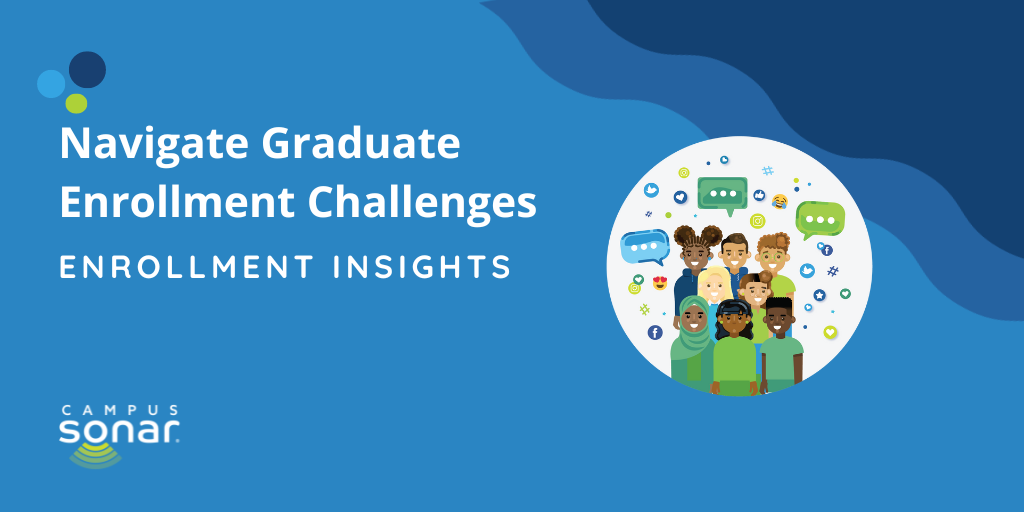Navigate Graduate Enrollment Challenges

With the demographic shift and many other changes happening on higher ed campuses, leveraging graduate enrollment as a campus growth opportunity is top of mind for many. Before you begin development, it’s critical to think through how to build competitive graduate programs and understand how to effectively recruit and retain graduate students.
Graduate enrollment and marketing experts Keith Ramsdell (Vice President for Enrollment Marketing, Ashland University) and Shane Baglini (Senior Director of Marketing, Muhlenberg College) discussed navigating graduate enrollment growth with me during our roundtable discussion series.
How Grad Enrollment Fits Into the Campus Landscape
For many years, higher ed institutions expected graduate programs to make up the difference as the industry experiences the demographic shift. But the opportunities aren’t equal for all grad programs across the board. Many enrollment managers face unrealistic goals and growth, unless they’re a larger campus that has an easier time leveraging grad programs to drive financial stability. There are also more options available that aren’t traditional higher ed and the competitor set has expanded past traditional degree-granting institutions to online courses, certificates, and peer-learning opportunities.
Focus on Differentiation and Outcomes
It’s a challenge to determine how to differentiate and market grad programs to stand out amongst the crowd. Keith shared that he’s had success being honest with his colleagues—small class sizes, personalized attention, etc. are no longer differentiators. Instead, you have to focus on outcomes and products. As an industry, we need to focus on outcomes as we have with undergraduates. When these students come to the graduate side, their expectation is knowing the return on their investment.
Guest Thom Chesney (incoming President at Southwestern College) shared a framework for gradate enrollment management (GEM) practitioners to use in thinking about what differentiates their campus: My graduate degree at [X campus] provided me with [Y outcome] with the ability to pay my bills/loans.
This aligns with social intelligence findings from our research: prospective graduate students regularly express concerns about cost, financial aid, and the value of a graduate degree.
When you think about how you communicate with students, it’s a very different experience than choosing your undergraduate institution, it’s a transactional decision. Shane compared it to buying a car or house because you need all the information upfront and it’s a major investment in time, money, and sacrifice. At Muhlenberg, they stopped using the work life school balance paradigm in an effort to be upfront with students that “this is going to be challenging, but here’s how we support you.”
Transparency, framing messaging with outcomes, and listening to your audience are all strategies we recommend for how to rebuild trust in our social intelligence research.
Leverage Data to Make Grad Program and Marketing Decisions
When thinking about your prospective graduate students’ concerns or what they look for from their potential graduate experience, institutional and audience data is critical.
Shane recently audited Muhlenberg College’s graduate communications flow to understand where prospects fall off and/or don’t engage and where they do engage to inform strategic change.
Keith surveys current students to know why they enrolled and attended—asking everything from how they heard about the campus, what social media channels they regularly use, what marketing initiatives they engage with, what first attracted them to campus, etc.
The direct feedback from alumni and prospective student surveys is critical to inform marketing strategies that resonate with your audience. Social intelligence research is another option for direct audience feedback—it’s an “always on focus group” of your prospective and admitted students that offers faster results and real-time feedback.
Market demand is also an important data indicator that contributes to strong development and marketing decisions for new grad programs. Shane loops in the campus marketing team early in the process to consider search volume and how marketable a new program might actually be.
Guest Kittie Pain (Director of Graduate Admissions, Kutztown University) noted the importance of understanding the industry demands for your region, such as considering the community and employer needs, and where job growth will be. Thom Chesney shared in the chat that exploring how your campus can fulfill community needs is a way to explore what investment for your programs could look like.
Identify Your Change Champions and Build Relationships for Buy In
Data from surveys, CRMs, job growth, market analysis, and social intelligence are fantastic ways to drive change on campus and grow graduate enrollment. But any change can be challenging and change on a college campus is often fraught with unique roadblocks and opportunities.
Keith and Shane affirmed the importance of identifying your champions for graduate enrollment growth and change. For Shane, having your President in your corner is critical for success and Keith affirmed that champions for change are typically folx with an entrepreneurial spirit and willingness to think outside the box, whether it’s administrators or faculty.
Building relationships with faculty is a focus for Keith, as he’s always looking for ways to translate the needs on both sides for mutual benefit of the campus. But as important as change champions are, it’s equally important to cultivate a mindset of change on campus. Being okay with trial and error is something Keith supports on his team: plan, do, evaluate, make adjustments, repeat. Don’t be afraid to innovate or do something different.
There’s much more to this conversation with Shane and Keith. Watch the entire conversation and download our research on how to navigate the challenges in graduate enrollment.

